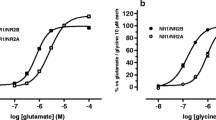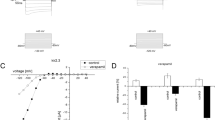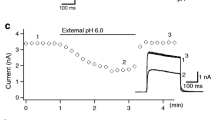Abstract
Ifenprodil has been known to reduce cardiac contractility and cerebral vasodilation by antagonizing α1-adrenergic and N-methyl D-aspartate receptor-mediated intracellular signals. This study aimed to investigate the direct effect of ifenprodil on the human voltage-gated Kv1.5 channel (hKv1.5) by using a Xenopus oocyte expression system and a two-microelectrode voltage clamp technique. The amplitudes of hKv1.5 currents, including peak and steady state, were suppressed in a concentration-dependent manner (IC50; 43.1 and 35.5 μM, respectively) after 6 min of ifenprodil treatment. However, these effects were ~ 80% reversed by washout, suggesting that ifenprodil directly inhibited the hKv1.5 independent of membrane receptors or intracellular signals. The inhibition rate of steady state showed voltage dependence, wherein the rates increased according to test voltage depolarization. Ifenprodil reduced the time constants of hKv1.5 inactivation but has higher effects on activation. hKv1.5 inhibition by ifenprodil showed use dependency because the drug more rapidly reduced the current at the higher activation frequencies, and subsequent reduction in frequency after high activation frequency caused a partial channel block relief. Therefore, ifenprodil directly blocked the hKv1.5 in an open state and accelerated the time course of the channel inactivation, which provided a biophysical mechanism for the hKv1.5 blocking effects of ifenprodil.









Similar content being viewed by others
Availability of data and materials
Availability of data and materials in this work is not applicable.
References
Aydar E, Palmer CP, Klyachko VA, Jackson MB (2002) The sigma receptor as a ligand-regulated auxiliary potassium channel subunit. Neuron 34(3):399–410
Bath CP, Farrell LN, Gilmore J, Ward MA, Hicks CA, O’Neill MJ, Bleakman D (1996) The effects of ifenprodil and eliprodil on voltage-dependent Ca2+ channels and in gerbil global cerebral ischaemia. Eur J Pharmacol 299(1–3):103–112
Bettahi I, Marker CL, Roman MI, Wickman K (2002) Contribution of the Kir3.1 subunit to the muscarinic-gated atrial potassium channel IKACh. J Biol Chem 277:48282–48288
Brittain MK, Brustovetsky T, Brittain JM, Khanna R, Cummins TR, Brustovetsky N (2012) Ifenprodil, a NR2B-selective antagonist of NMDA receptor, inhibits reverse Na+/Ca2+ exchanger in neurons. Neuropharmacology 63(6):974–982
Brunner M, Kodirov S, Mitchell GF, Buckett PD, Shibata K, Folco EJ, Baker L, Salama G, Chan DP, Zhou J, Koren G (2003) In vivo gene transfer of Kv1.5 normalizes action potential duration and shortens QT interval in mice with long QT phenotype. Am J Physiol Heart Circ Physiol 285:H194–H203
Carron C, Jullien A, Bucher B (1971) Synthesis and pharmacological properties of a series of 2-piperidino alkanol derivatives. Arzneimittelforschung 21:1992–1998
Chenard BL, Shalaby IA, Koe BK, Ronau RT, Butler TW, Prochniak MA, Schmidt AW, Fox CB (1991) Separation of alpha 1adrenergic and N-methyl-D-aspartate antagonist activity in a series of ifenprodil compounds. J Med Chem 34:3085–3090
Choi BH, Choi JS, Jeong SW, Hahn SJ, Yoon SH, Jo YH, Kim MS (2000) Direct block by bisindolylmaleimide of rat Kv1.5 expressed in Chinese hamster ovary cells. J Pharmacol Exp Ther 293:634–640
Christ T, Wettwer E, Voigt N, Hála O, Radicke S, Matschke K, Várro A, Dobrev D, Ravens U (2008) Pathology-specific effects of the IKur/Ito/IK, ACh blocker AVE0118 on ion channels in human chronic atrial fibrillation. Br J Pharmacol 154:1619–1630
Christophersen IE, Olesen MS, Liang B, Andersen MN, Larsen AP, Nielsen JB, Haunsø S, Olesen SP, Tveit A, Svendsen JH, Schmitt N (2013) Genetic variation in KCNA5: impact on the atrial-specific potassium current IKur in patients with lone atrial fibrillation. Eur Heart J 34:1517–1525
Church J, Fletcher EJ, Baxter K, MacDonald JF (1994) Blockade by ifenprodil of high voltage-activated Ca2+ channels in rat and mouse cultured hippocampal pyramidal neurones: comparison with N-methyl-D-aspartate receptor antagonist actions. Br J Pharmacol 113(2):499–507
Colatsky TJ, Follmer CH, Starmer CF (1990) Channel specificity in antiarrhythmic drug action. Mechanism of potassium channel block and its role in suppressing and aggravating cardiac arrhythmias. Circulation 82:2235–2242
Delpon E, Valenzuela C, Gay P, Franqueza L, Snyders DJ, Tamargo J (1997) Block of human cardiac Kv1.5 channels by loratadine: voltage-, time-, and use-dependent block at concentrations above therapeutic levels. Cardiovasc Res 35:341–350
Doupnik CA, Davidson N, Lester HA (1995) The inward rectifier potassium channel family. Curr Opin Neurobiol 5:268–277
Ehrlich JR, Biliczki P, Hohnloser SH, Nattel S (2008) Atrial-selective approaches for the treatment of atrial fibrillation. J Am Coll Cardiol 51:787–792
Fedida D, Wible B, Wang Z, Fermini B, Faust F, Nattel S, Brown AM (1993) Identity of a novel delayed rectifier current from human heart with a cloned K+ channel current. Circ Res 73:210–216
Ford JW, Milnes JT (2008) New drugs targeting the cardiac ultra-rapid delayed-rectifier current (I Kur): rationale, pharmacology and evidence for potential therapeutic value. J Cardiovasc Pharmacol 52:105–120
Ford J, Milnes J, Wettwer E, Christ T, Rogers M, Sutton K, Madge D, Virag L, Jost N, Horvath Z, Matschke K, Varro A, Ravens U (2013) Human electrophysiological and pharmacological properties of XEN-D0101: a novel atrial-selective Kv1.5/IKur inhibitor. J Cardiovasc Pharmacol 61:408–415
Ford J, Milnes J, El Haou S, Wettwer E, Loose S, Matschke K, Tyl B, Round P, Ravens U (2016) The positive frequency-dependent electrophysiological effects of the IKur inhibitor XEN-D0103 are desirable for the treatment of atrial fibrillation. Heart Rhythm 13:555–564
Guo X, Chen W, Sun H, You Q (2016) Kv1.5 inhibitors for treatment of atrial fibrillation: a tradeoff between selectivity and non-selectivity. Curr Top Med Chem 16:1843–1854
Gutman GA, Chandy KG, Grissmer S, Lazdunski M, McKinnon D, Pardo LA, Robertson GA, Rudy B, Sanguinetti MC, Stühmer W, Wang X (2005) International Union of Pharmacology. LIII. Nomenclature and molecular relationships of voltage-gated potassium channels. Pharmacol Rev 57:473–508
Hashimoto K, London ED (1993) Further characterization of [3H] ifenprodil binding to sigma receptors in rat brain. Eur J Pharmacol 236:159–163
Hashimoto K, London ED (1995) Interactions of erythro-ifenprodil, threo-ifenprodil, erythro-iodoifenprodil, and eliprodil with subtypes of sigma receptors. Eur J Pharmacol 273:307–310
Hashimoto K, Mantione CR, Spada MR, Neumeyer JL, London ED (1994) Further characterization of [3H] ifenprodil binding in rat brain. Eur J Pharmacol 266:67–77
Hautz T, Krapf C, Grahammer J, Zelger B, Hickethier T, Seger C, Eberhart N, Wallner C, Messner F, Kotsch K, Griesmacher A, Brandacher G, Lee WP, Margreiter R, Pratschke J, Glossmann H, Schneeberger S (2013) Targeting the Kv1.3 potassium channel for immunosuppression in vascularized composite allotransplantation: a pilot study. Transpl Int 26:552–561
Hayashi K, Konno T, Tada H, Tani S, Liu L, Fujino N, Nohara A, Hodatsu A, Tsuda T, Tanaka Y, Kawashiri MA, Ino H, Makita N, Yamagishi M (2015) Functional characterization of rare variants implicated in susceptibility to lone atrial fibrillation. Circ Arrhythm Electrophysiol 8:1095–1104
Hu L, Wang T, Gocke AR, Nath A, Zhang H, Margolick JB, Whartenby KA, Calabresi PA (2013) Blockade of Kv1.3 potassium channels inhibits differentiation and granzyme B secretion of human CD8+ T effector memory lymphocytes. PLoS ONE 8:e54267
Hwang S, Kim JH, Jo SH (2021) Inhibitory effect of the selective serotonin reuptake inhibitor paroxetine on human Kv1.3 channels. Eur J Pharmacol 912:174567
Jo SH, Hong HK, Chong SH, Choe H (2008) Protriptyline block of the human ether-à-go-go-related gene (HERG) K+ channel. Life Sci 82:331–340
Karbon EW, Patch RJ, Pontecorvo MJ, Ferkany JW (1990) Ifenprodil potently interacts with [3H](+)-3-PPP-labeled sigma binding sites in guinea pig brain membranes. Eur J Pharmacol 176:247–248
Kidd MW, Bulley S, Jaggar JH (2017) Angiotensin II reduces the surface abundance of KV 1.5 channels in arterial myocytes to stimulate vasoconstriction. J Physiol 595:1607–1618
Kobayashi T, Washiyama K, Ikeda K (2006) Inhibition of G protein-activated inwardly rectifying K+ channels by ifenprodil. Neuropsychopharmacology 31:516–524
Kotecha SA, Schlichter LC (1999) A Kv1.5 to Kv1.3 switch in endogenous hippocampal microglia and a role in proliferation. J Neurosci 19:10680–10693
Krapivinsky G, Gordon EA, Wickman K, Velimirovic B, Krapivinsky L, Clapham DE (1995) The G-protein-gated atrial K+ channel IKACh is a heteromultimer of two inwardly rectifying K+ -channel proteins. Nature 374:135–141
Lee HM, Hahn SJ, Choi BH (2010) Open channel block of Kv1.5 currents by citalopram. Acta Pharmacol Sin 31:429–435
Lip GY, Tse HF (2007) Management of atrial fibrillation. Lancet 370:604–618
Loose S, Mueller J, Wettwer E, Knaut M, Ford J, Milnes J, Ravens U (2014) Effects of IKur blocker MK-0448 on human right atrial action potentials from patients in sinus rhythm and in permanent atrial fibrillation. Front Pharmacol 5:26
Marquis P, Lecasble M, Passa P (1998) Quality of life of patient with peripheral arterial obliterative disease treated with ifenprodil tartrate. Results of an ARTEMIS study. Drugs 56(Suppl 3):37–48
McCool BA, Lovinger DM (1995) Ifenprodil inhibition of the 5-hydroxytryptamine3 receptor. Neuropharmacology 34:621–629
Monassier L, Bousquet P (2002) Sigma receptors: from discovery to highlights of their implications in the cardiovascular system. Fundam Clin Pharmacol 16:1–8
Monassier L, Tibiriça E, Roegel JC, Mettauer B, Feldman J, Bousquet P (1994) Prevention by NMDA receptor antagonists of the centrally-evoked increases of cardiac inotropic responses in rabbits. Br J Pharmacol 111:1347–1354
Monassier L, Riehl V, Lienhard JP, Tibiriça E, Feldman J, Bousquet P (1999) Effects of ifenprodil and baclofen on exercise-induced increase of myocardial oxygen demand in normotensive rats. J Pharmacol Exp Ther 290(3):1188–1194
Monassier L, Brandt CM, Bousquet P (2001) Effects of centrally-acting glutamatergic modulators on cardiovascular responses to stress in humans. J Cardiol 37(Suppl 1):77–84
Monassier L, Manoury B, Bellocq C, Weissenburger J, Greney H, Zimmermann D, Ehrhardt JD, Jaillon P, Baró I, Bousquet P (2007) σ2-Receptor ligand-mediated inhibition of inwardly rectifying K+ channels in the heart. J Pharmacol Exp Ther 322:341–350
Nakagawa H, Yamano S, Nikawa K, Matsumoto Y, Suga T (1975) Metabolic fate of dl-erythro-2-(4-benzylpiperidino)-1-(4-hydrophenyl)-1-propanol I. Absorption, distribution and excretion in the rat and mouse. Pharmacometrics 10:283–291
Novakova M, Ela C, Bowen WD, Hasin Y, Bowen EYWD, Hasin Y, Eilam Y (1998) Highly selective sigma receptor ligands elevate inositol 1,4,5-trisphosphate production in rat cardiac myocytes. Eur J Pharmacol 353:315–327
Ohanyan V, Yin L, Bardakjian R, Kolz C, Enrick M, Hakobyan T, Kmetz J, Bratz I, Luli J, Nagane M, Khan N, Hou H, Kuppusamy P, Graham J, Fu FK et al (2015) Requisite role of Kv1.5 channels in coronary metabolic dilation. Circ Res 117:612–621
Olson TM, Alekseev AE, Liu XK, Park S, Zingman LV, Bienengraeber M, Sattiraju S, Ballew JD, Jahangir A, Terzic A (2006) Kv1.5 channelopathy due to KCNA5 loss-of-function mutation causes human atrial fibrillation. Hum Mol Genet 15:2185–2191
Pratt CM, Camm AJ, Cooper W, Friedman PL, MacNeil DJ, Moulton KM, Pitt B, Schwartz PJ, Veltri EP, Waldo AL (1998) Mortality in the survival with ORal D-sotalol (SWORD) trial: why did patients die? Am J Cardiol 81:869–876
Reimann F, Ashcroft FM (1999) Inwardly rectifying potassium channels. Curr Opin Cell Biol 11:503–508
Ru Q, Tian X, Wu YX, Wu RH, Pi MS, Li CY (2014) Voltage-gated and ATP-sensitive K+ channels are associated with cell proliferation and tumorigenesis of human glioma. Oncol Rep 31:842–848
Seo MS, Kang M, An JR, Heo R, Jung WK, Choi IW, Han ET, Han JH, Chun W, Park WS (2022) Asenapine, an atypical antipsychotic, blocks voltage-gated potassium channels in rabbit coronary artery smooth muscle cells. Eur J Pharmacol 934:175318
Suessbrich H, Schönherr R, Heinemann SH, Attali B, Lang F, Busch AE (1997) The inhibitory effect of the antipsychotic drug haloperidol on HERG potassium channels expressed in Xenopus oocytes. Br J Pharmacol 120(5):968–974
Sung MJ, Ahn HS, Hahn SJ, Choi BH (2008) Open channel block of Kv3.1 currents by fluoxetine. J Pharmacol Sci 106:38–45
Swanson R, Marshall J, Smith JS, Williams JB, Boyle MB, Folander K, Luneau CJ, Antanavage J, Oliva C, Buhrow SA, Bennet C, Stein RB, Kaczmarek LK (1990) Cloning and expression of cDNA and genomic clones encoding three delayed rectifier potassium channels in rat brain. Neuron 4:929–939
Walfridsson H, Anfinsen OG, Berggren A, Frison L, Jensen S, Linhardt G, Nordkam AC, Sundqvist M, Carlsson L (2015) Is the acetylcholine-regulated inwardly rectifying potassium current a viable antiarrhythmic target? Translational discrepancies of AZD2927 and A7071 in dogs and humans. Europace 17:473–482
Wang Z, Fermini B, Nattel S (1993) Sustained depolarization induced outward current in human atrial myocytes: evidence for a novel delayed rectifier K+ current similar to Kv1.5 cloned channel currents. Circ Res 73:1061–1076
Wettwer E, Hála O, Christ T, Heubach JF, Dobrev D, Knaut M, Varró A, Ravens U (2004) Role of IKur in controlling action potential shape and contractility in the human atrium: influence of chronic atrial fibrillation. Circulation 110:2299–2306
Williams K (2001) Ifenprodil, a novel NMDA receptor antagonist: site and mechanism of action. Curr Drug Targets 2:285–298
Wulff H, Calabresi PA, Allie R, Yun S, Pennington M, Beeton C, Chandy KG (2003) The voltage-gated Kv1.3 K(+) channel in effector memory T cells as new target for MS. J Clin Invest 111:1703–1713
Wulff H, Castle NA, Pardo LA (2009) Voltage-gated potassium channels as therapeutic targets. Nat Rev Drug Discov 8:982–1001
Yang J, Lu C, Song W, Li J, Ding Y, Zhu Y, Cao J, Ding L, Jia Y, Wen A (2013) Determination of ifenprodil by LC-MS/MS and its application to a pharmacokinetic study in health Chinese volunteers. Act Pharmacuetica Sin B3:180–184
Young AR, Bouloy M, Boussard JF, Edvinsson L, MacKenzie ET (1981) Direct vascular effects of agents used in the pharmacotherapy of cerebrovascular disease on isolated cerebral vessels. J Cereb Blood Flow Metab 1:117–128
Young AR, Barry DI, MacKenzie ET, Robert JP (1983) Cerebro-circulatory effects of socalled “vasodilators” in the anaesthetised rat. Eur Neurol 22:142–153
Funding
This work was supported by the National Research Foundation of Korea (NRF) grant funded by the Korean government (MSIT) (no. 2020R1A2C1013958).
Author information
Authors and Affiliations
Contributions
Soobeen Hwang: data collection, designing the figure, and manuscript wiring. Byeongjun Yoon: manuscript wiring. Su-Hyun Jo: writing, reviewing, and editing. The authors declare that all data were generated in-house and that no paper mill was used.
Corresponding author
Ethics declarations
Ethical approval
The experimental procedures were conducted under the Research Guidelines of Kangwon National University Institutional Animal Care and Use Committee.
Competing interests
The authors declare no competing interests.
Additional information
Publisher's note
Springer Nature remains neutral with regard to jurisdictional claims in published maps and institutional affiliations.
Rights and permissions
Springer Nature or its licensor (e.g. a society or other partner) holds exclusive rights to this article under a publishing agreement with the author(s) or other rightsholder(s); author self-archiving of the accepted manuscript version of this article is solely governed by the terms of such publishing agreement and applicable law.
About this article
Cite this article
Hwang, S., Yoon, B. & Jo, SH. Inhibitory effects of N-methyl-D-aspartate (NMDA) and α1-adrenergic receptor antagonist ifenprodil on human Kv1.5 channel. Naunyn-Schmiedeberg's Arch Pharmacol 396, 3149–3161 (2023). https://doi.org/10.1007/s00210-023-02521-6
Received:
Accepted:
Published:
Issue Date:
DOI: https://doi.org/10.1007/s00210-023-02521-6




